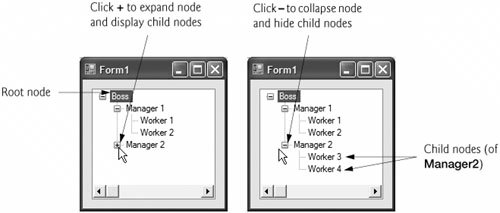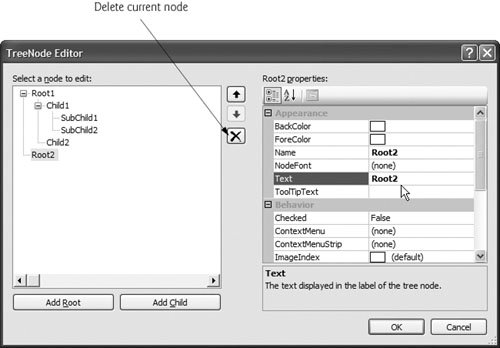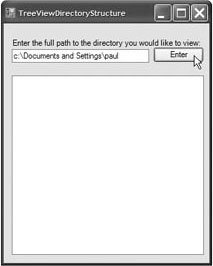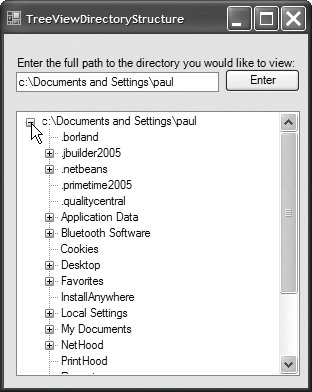TreeView Control
The treeView control displays nodes hierarchically in a tree. Traditionally, nodes are objects that contain values and can refer to other nodes. A parent node contains child nodes, and the child nodes can be parents to other nodes. Two child nodes that have the same parent node are considered sibling nodes. A tree is a collection of nodes, usually organized in a hierarchical manner. The first parent node of a tree is the root node (a treeView can have multiple roots). For example, the file system of a computer can be represented as a tree. The top-level directory (perhaps C:) would be the root, each subfolder of C: would be a child node and each child folder could have its own children. TReeView controls are useful for displaying hierarchal information, such as the file structure that we just mentioned. We cover nodes and trees in greater detail in Chapter 25, Data Structures. Figure 14.24 displays a sample treeView control on a Form.
Figure 14.24. TReeView displaying a sample tree.

A parent node can be expanded or collapsed by clicking the plus box or minus box to its left. Nodes without children do not have these boxes.
The nodes in a treeView are instances of class treeNode. Each TReeNode has a Nodes collection (type treeNodeCollection), which contains a list of other treeNodesknown as its children. The Parent property returns a reference to the parent node (or null if the node is a root node). Figure 14.25 and Fig. 14.26 list the common properties of treeViews and TReeNodes, common treeNode methods and a common TReeView event.
|
treeView properties and an event |
Description |
|---|---|
|
Common Properties |
|
|
CheckBoxes |
Indicates whether CheckBoxes appear next to nodes. A value of TRue displays CheckBoxes. The default value is false. |
|
ImageList |
Specifies an ImageList object containing the node icons. An ImageList object is a collection that contains Image objects. |
|
Nodes |
Lists the collection of treeNodes in the control. It contains methods Add (adds a treeNode object), Clear (deletes the entire collection) and Remove (deletes a specific node). Removing a parent node deletes all of its children. |
|
SelectedNode |
The selected node. |
|
Common Event (Event arguments TreeViewEventArgs) |
|
|
AfterSelect |
Generated after selected node changes. This is the default event when the control is double clicked in the designer. |
|
TReeNode properties and methods |
Description |
|---|---|
|
Common Properties |
|
|
Checked |
Indicates whether the treeNode is checked (CheckBoxes property must be set to true in the parent treeView). |
|
FirstNode |
Specifies the first node in the Nodes collection (i.e., the first child in the tree). |
|
FullPath |
Indicates the path of the node, starting at the root of the tree. |
|
ImageIndex |
Specifies the index of the image shown when the node is deselected. |
|
LastNode |
Specifies the last node in the Nodes collection (i.e., the last child in the tree). |
|
NextNode |
Next sibling node. |
|
Nodes |
Collection of TReeNodes contained in the current node (i.e., all the children of the current node). It contains methods Add (adds a treeNode object), Clear (deletes the entire collection) and Remove (deletes a specific node). Removing a parent node deletes all of its children. |
|
PrevNode |
Previous sibling node. |
|
SelectedImageIndex |
Specifies the index of the image to use when the node is selected. |
|
Text |
Specifies the TReeNode's text. |
|
Common Methods |
|
|
Collapse |
Collapses a node. |
|
Expand |
Expands a node. |
|
ExpandAll |
Expands all the children of a node. |
|
GetNodeCount |
Returns the number of child nodes. |
To add nodes to the TReeView visually, click the ellipsis next to the Nodes property in the Properties window. This opens the TreeNode Editor (Fig. 14.27), which displays an empty tree representing the treeView. There are Buttons to create a root, and to add or delete a node. To the right are the properties of current node. Here you can rename the node.
Figure 14.27. TreeNode Editor..
(This item is displayed on page 681 in the print version)

To add nodes programmatically, first create a root node. Create a new TReeNode object and pass it a string to display. Then call method Add to add this new TReeNode to the treeView's Nodes collection. Thus, to add a root node to treeView myTreeView, write
myTreeView.Nodes.Add( new TreeNode( rootLabel ) );
where myTreeView is the TReeView to which we are adding nodes, and rootLabel is the text to display in myTreeView. To add children to a root node, add new TReeNodes to its Nodes collection. We select the appropriate root node from the treeView by writing
myTreeView.Nodes[ myIndex ]
where myIndex is the root node's index in myTreeView's Nodes collection. We add nodes to child nodes through the same process by which we added root nodes to myTreeView. To add a child to the root node at index myIndex, write
myTreeView.Nodes[ myIndex ].Nodes.Add( new TreeNode( ChildLabel ) );
Class treeViewDirectoryStructureForm (Fig. 14.28) uses a treeView to display the contents of a directory chosen by the user. A TextBox and a Button are used to specify the directory. First, enter the full path of the directory you want to display. Then click the Button to set the specified directory as the root node in the treeView. Each subdirectory of this directory becomes a child node. This layout is similar to that used in Windows Explorer. Folders can be expanded or collapsed by clicking the plus or minus boxes that appear to their left.
Figure 14.28. treeView used to display directories.
(This item is displayed on pages 681 - 683 in the print version)
1 // Fig. 14.28: TreeViewDirectoryStructureForm.cs
2 // Using TreeView to display directory structure.
3 using System;
4 using System.Windows.Forms;
5 using System.IO;
6
7 // Form uses TreeView to display directory structure
8 public partial class TreeViewDirectoryStructureForm : Form
9 {
10 string substringDirectory; // store last part of full path name 11 12 // default constructor 13 public TreeViewDirectoryStructureForm() 14 { 15 InitializeComponent(); 16 } // end constructor 17 18 // populate current node with subdirectories 19 public void PopulateTreeView( 20 string directoryValue, TreeNode parentNode ) 21 { 22 // array stores all subdirectories in the directory 23 string[] directoryArray = 24 Directory.GetDirectories( directoryValue ); 25 26 // populate current node with subdirectories 27 try 28 { 29 // check to see if any subdirectories are present 30 if ( directoryArray.Length != 0 ) 31 { 32 // for every subdirectory, create new TreeNode, 33 // add as a child of current node and recursively 34 // populate child nodes with subdirectories 35 foreach ( string directory in directoryArray ) 36 { 37 // obtain last part of path name from the full path name 38 // by finding the last occurence of "" and returning the 39 // part of the path name that comes after this occurence 40 substringDirectory = directory.Substring( 41 directory.LastIndexOf( '\' ) + 1, 42 directory.Length - directory.LastIndexOf( '\' ) - 1 ); 43 44 // create TreeNode for current directory 45 TreeNode myNode = new TreeNode( substringDirectory ); 46 47 // add current directory node to parent node 48 parentNode.Nodes.Add( myNode ); 49 50 // recursively populate every subdirectory 51 PopulateTreeView( directory, myNode ); 52 } // end foreach 53 } // end if 54 } //end try 55 56 // catch exception 57 catch ( UnauthorizedAccessException ) 58 { 59 parentNode.Nodes.Add( "Access denied" ); 60 } // end catch 61 } // end method PopulateTreeView
62 63 // handles enterButton click event 64 private void enterButton_Click( object sender, EventArgs e ) 65 { 66 // clear all nodes 67 directoryTreeView.Nodes.Clear(); 68 69 // check if the directory entered by user exists 70 // if it does then fill in the TreeView, 71 // if not display error MessageBox 72 if ( Directory.Exists( inputTextBox.Text ) ) 73 { 74 // add full path name to directoryTreeView 75 directoryTreeView.Nodes.Add( inputTextBox.Text ); 76 77 // insert subfolders 78 PopulateTreeView( 79 inputTextBox.Text, directoryTreeView.Nodes[ 0 ] ); 80 } 81 // display error MessageBox if directory not found 82 else 83 MessageBox.Show( inputTextBox.Text + " could not be found.", 84 "Directory Not Found", MessageBoxButtons.OK, 85 MessageBoxIcon.Error ); 86 } // end method enterButton_Click 87 } // end class TreeViewDirectoryStructureForm
(a)
(b)
|
When the user clicks the enterButton, all the nodes in directoryTreeView are cleared (line 67). Then the path entered in inputTextBox is used to create the root node. Line 75 adds the directory to directoryTreeView as the root node, and lines 7879 call method PopulateTreeView (lines 1961), which takes a directory (a string) and a parent node. Method PopulateTreeView then creates child nodes corresponding to the subdirectories of the directory it receives as an argument.
Method PopulateTreeView (lines 1961) obtains a list of subdirectories, using method GeTDirectories of class Directory (namespace System.IO) in lines 2324. Method GeTDirectories takes a string (the current directory) and returns an array of strings (the subdirectories). If a directory is not accessible for security reasons, an UnauthorizedAccessException is thrown. Lines 5760 catch this exception and add a node containing "Access Denied" instead of displaying the subdirectories.
If there are accessible subdirectories, lines 4042 use the Substring method to increase readability by shortening the full path name to just the directory name. Next, each string in the directoryArray is used to create a new child node (line 45). We use method Add (line 48) to add each child node to the parent. Then method PopulateTreeView is called recursively on every subdirectory (line 51), which eventually populates the TReeView with the entire directory structure. Note that our recursive algorithm may cause a delay when the program loads large directories. However, once the folder names are added to the appropriate Nodes collection, they can be expanded and collapsed without delay. In the next section, we present an alternate algorithm to solve this problem.
Preface
Index
Introduction to Computers, the Internet and Visual C#
- Introduction
- What Is a Computer?
- Computer Organization
- Early Operating Systems
- Personal Computing, Distributed Computing and Client/Server Computing
- Hardware Trends
- Microsofts Windows® Operating System
- Machine Languages, Assembly Languages and High-Level Languages
- C#
- C, C++, Java and Visual Basic
- Other High-Level Languages
- The Internet and the World Wide Web
- Extensible Markup Language (XML)
- Microsofts .NET
- The .NET Framework and the Common Language Runtime
- Test-Driving a C# Application
- Software Engineering Case Study: Introduction to Object Technology and the UML
- Wrap-Up
- Web Resources
- Summary
- Terminology
- Self-Review Exercises
- Exercises
Introduction to the Visual C# 2005 Express Edition IDE
- Introduction
- Overview of the Visual Studio 2005 IDE
- Menu Bar and Toolbar
- Navigating the Visual Studio 2005 IDE
- Using Help
- Using Visual Programming to Create a Simple Program Displaying Text and an Image
- Wrap-Up
- Web Resources
- Summary
- Terminology
- Self-Review Exercises
- Exercises
Introduction to C# Applications
- Introduction
- A Simple C# Application: Displaying a Line of Text
- Creating Your Simple Application in Visual C# Express
- Modifying Your Simple C# Application
- Formatting Text with Console.Write and Console.WriteLine
- Another C# Application: Adding Integers
- Memory Concepts
- Arithmetic
- Decision Making: Equality and Relational Operators
- (Optional) Software Engineering Case Study: Examining the ATM Requirements Document
- Wrap-Up
- Summary
- Terminology
- Self-Review Exercises
- Exercises
Introduction to Classes and Objects
- Introduction
- Classes, Objects, Methods, Properties and Instance Variables
- Declaring a Class with a Method and Instantiating an Object of a Class
- Declaring a Method with a Parameter
- Instance Variables and Properties
- UML Class Diagram with a Property
- Software Engineering with Properties and set and get Accessors
- Value Types vs. Reference Types
- Initializing Objects with Constructors
- Floating-Point Numbers and Type decimal
- (Optional) Software Engineering Case Study: Identifying the Classes in the ATM Requirements Document
- Wrap-Up
- Summary
- Terminology
- Self-Review Exercises
- Exercises
Control Statements: Part 1
- Introduction
- Algorithms
- Pseudocode
- Control Structures
- if Single-Selection Statement
- if...else Double-Selection Statement
- while Repetition Statement
- Formulating Algorithms: Counter-Controlled Repetition
- Formulating Algorithms: Sentinel-Controlled Repetition
- Formulating Algorithms: Nested Control Statements
- Compound Assignment Operators
- Increment and Decrement Operators
- Simple Types
- (Optional) Software Engineering Case Study: Identifying Class Attributes in the ATM System
- Wrap-Up
- Summary
- Terminology
- Self-Review Exercises
- Exercises
Control Statements: Part 2
- Introduction
- Essentials of Counter-Controlled Repetition
- for Repetition Statement
- Examples Using the for Statement
- do...while Repetition Statement
- switch Multiple-Selection Statement
- break and continue Statements
- Logical Operators
- Structured Programming Summary
- (Optional) Software Engineering Case Study: Identifying Objects States and Activities in the ATM System
- Wrap-Up
- Summary
- Terminology
- Self-Review Exercises
- Exercises
Methods: A Deeper Look
- Introduction
- Packaging Code in C#
- static Methods, static Variables and Class Math
- Declaring Methods with Multiple Parameters
- Notes on Declaring and Using Methods
- Method Call Stack and Activation Records
- Argument Promotion and Casting
- The Framework Class Library
- Case Study: Random-Number Generation
- Case Study: A Game of Chance (Introducing Enumerations)
- Scope of Declarations
- Method Overloading
- Recursion
- Passing Arguments: Pass-by-Value vs. Pass-by-Reference
- (Optional) Software Engineering Case Study: Identifying Class Operations in the ATM System
- Wrap-Up
- Summary
- Terminology
- Self-Review Exercises
- Exercises
Arrays
- Introduction
- Arrays
- Declaring and Creating Arrays
- Examples Using Arrays
- Case Study: Card Shuffling and Dealing Simulation
- foreach Statement
- Passing Arrays and Array Elements to Methods
- Passing Arrays by Value and by Reference
- Case Study: Class GradeBook Using an Array to Store Grades
- Multidimensional Arrays
- Case Study: Class GradeBook Using a Rectangular Array
- Variable-Length Argument Lists
- Using Command-Line Arguments
- (Optional) Software Engineering Case Study: Collaboration Among Objects in the ATM System
- Wrap-Up
- Summary
- Terminology
- Self-Review Exercises
- Exercises
- Special Section: Building Your Own Computer
Classes and Objects: A Deeper Look
- Introduction
- Time Class Case Study
- Controlling Access to Members
- Referring to the Current Objects Members with the this Reference
- Indexers
- Time Class Case Study: Overloaded Constructors
- Default and Parameterless Constructors
- Composition
- Garbage Collection and Destructors
- static Class Members
- readonly Instance Variables
- Software Reusability
- Data Abstraction and Encapsulation
- Time Class Case Study: Creating Class Libraries
- internal Access
- Class View and Object Browser
- (Optional) Software Engineering Case Study: Starting to Program the Classes of the ATM System
- Wrap-Up
- Summary
- Terminology
- Self-Review Exercises
- Exercises
Object-Oriented Programming: Inheritance
- Introduction
- Base Classes and Derived Classes
- protected Members
- Relationship between Base Classes and Derived Classes
- Constructors in Derived Classes
- Software Engineering with Inheritance
- Class object
- Wrap-Up
- Summary
- Terminology
- Self-Review Exercises
- Exercises
Polymorphism, Interfaces & Operator Overloading
- Introduction
- Polymorphism Examples
- Demonstrating Polymorphic Behavior
- Abstract Classes and Methods
- Case Study: Payroll System Using Polymorphism
- sealed Methods and Classes
- Case Study: Creating and Using Interfaces
- Operator Overloading
- (Optional) Software Engineering Case Study: Incorporating Inheritance and Polymorphism into the ATM System
- Wrap-Up
- Summary
- Terminology
- Self-Review Exercises
- Exercises
Exception Handling
- Introduction
- Exception Handling Overview
- Example: Divide by Zero Without Exception Handling
- Example: Handling DivideByZeroExceptions and FormatExceptions
- .NET Exception Hierarchy
- finally Block
- Exception Properties
- User-Defined Exception Classes
- Wrap-Up
- Summary
- Terminology
- Self-Review Exercises
- Exercises
Graphical User Interface Concepts: Part 1
- Introduction
- Windows Forms
- Event Handling
- Control Properties and Layout
- Labels, TextBoxes and Buttons
- GroupBoxes and Panels
- CheckBoxes and RadioButtons
- PictureBoxes
- ToolTips
- NumericUpDown Control
- Mouse-Event Handling
- Keyboard-Event Handling
- Wrap-Up
- Summary
- Terminology
- Self-Review Exercises
- Answers To Self-Review Exercises
- Exercises
Graphical User Interface Concepts: Part 2
- Introduction
- Menus
- MonthCalendar Control
- DateTimePicker Control
- LinkLabel Control
- ListBox Control
- CheckedListBox Control
- ComboBox Control
- TreeView Control
- ListView Control
- TabControl Control
- Multiple Document Interface (MDI) Windows
- Visual Inheritance
- User-Defined Controls
- Wrap-Up
- Summary
- Terminology
- Self-Review Exercises
- Exercises
Multithreading
- Introduction
- Thread States: Life Cycle of a Thread
- Thread Priorities and Thread Scheduling
- Creating and Executing Threads
- Thread Synchronization and Class Monitor
- Producer/Consumer Relationship without Thread Synchronization
- Producer/Consumer Relationship with Thread Synchronization
- Producer/Consumer Relationship: Circular Buffer
- Multithreading with GUIs
- Wrap-Up
- Summary
- Terminology
- Self-Review Exercises
- Exercises
Strings, Characters and Regular Expressions
- Introduction
- Fundamentals of Characters and Strings
- string Constructors
- string Indexer, Length Property and CopyTo Method
- Comparing strings
- Locating Characters and Substrings in strings
- Extracting Substrings from strings
- Concatenating strings
- Miscellaneous string Methods
- Class StringBuilder
- Length and Capacity Properties, EnsureCapacity Method and Indexer of Class StringBuilder
- Append and AppendFormat Methods of Class StringBuilder
- Insert, Remove and Replace Methods of Class StringBuilder
- Char Methods
- Card Shuffling and Dealing Simulation
- Regular Expressions and Class Regex
- Wrap-Up
- Summary
- Terminology
- Self-Review Exercises
- Exercises
Graphics and Multimedia
- Introduction
- Drawing Classes and the Coordinate System
- Graphics Contexts and Graphics Objects
- Color Control
- Font Control
- Drawing Lines, Rectangles and Ovals
- Drawing Arcs
- Drawing Polygons and Polylines
- Advanced Graphics Capabilities
- Introduction to Multimedia
- Loading, Displaying and Scaling Images
- Animating a Series of Images
- Windows Media Player
- Microsoft Agent
- Wrap-Up
- Summary
- Terminology
- Self-Review Exercises
- Exercises
Files and Streams
- Introduction
- Data Hierarchy
- Files and Streams
- Classes File and Directory
- Creating a Sequential-Access Text File
- Reading Data from a Sequential-Access Text File
- Serialization
- Creating a Sequential-Access File Using Object Serialization
- Reading and Deserializing Data from a Sequential-Access Text File
- Wrap-Up
- Summary
- Terminology
- Self-Review Exercises
- Exercises
Extensible Markup Language (XML)
- Introduction
- XML Basics
- Structuring Data
- XML Namespaces
- Document Type Definitions (DTDs)
- W3C XML Schema Documents
- (Optional) Extensible Stylesheet Language and XSL Transformations
- (Optional) Document Object Model (DOM)
- (Optional) Schema Validation with Class XmlReader
- (Optional) XSLT with Class XslCompiledTransform
- Wrap-Up
- Web Resources
- Summary
- Terminology
- Self-Review Exercises
- Exercises
Database, SQL and ADO.NET
- Introduction
- Relational Databases
- Relational Database Overview: Books Database
- SQL
- ADO.NET Object Model
- Programming with ADO.NET: Extracting Information from a Database
- Querying the Books Database
- Programming with ADO.NET: Address Book Case Study
- Using a DataSet to Read and Write XML
- Wrap-Up
- Web Resources
- Summary
- Terminology
- Self-Review Exercises
- Exercises
ASP.NET 2.0, Web Forms and Web Controls
- Introduction
- Simple HTTP Transactions
- Multitier Application Architecture
- Creating and Running a Simple Web-Form Example
- Web Controls
- Session Tracking
- Case Study: Connecting to a Database in ASP.NET
- Case Study: Secure Books Database Application
- Wrap-Up
- Web Resources
- Summary
- Terminology
- Self-Review Exercises
- Exercises
Web Services
- Introduction
- .NET Web Services Basics
- Simple Object Access Protocol (SOAP)
- Publishing and Consuming Web Services
- Session Tracking in Web Services
- Using Web Forms and Web Services
- User-Defined Types in Web Services
- Wrap-Up
- Web Resources
- Summary
- Terminology
- Self-Review Exercises
- Exercises
Networking: Streams-Based Sockets and Datagrams
- Introduction
- Connection-Oriented vs. Connectionless Communication
- Protocols for Transporting Data
- Establishing a Simple TCP Server (Using Stream Sockets)
- Establishing a Simple TCP Client (Using Stream Sockets)
- Client/Server Interaction with Stream-Socket Connections
- Connectionless Client/Server Interaction with Datagrams
- Client/Server Tic-Tac-Toe Using a Multithreaded Server
- WebBrowser Control
- .NET Remoting
- Wrap-Up
- Summary
- Terminology
- Self-Review Exercises
- Exercises
Searching and Sorting
- Introduction
- Searching Algorithms
- Sorting Algorithms
- Wrap-Up
- Summary
- Terminology
- Self-Review Exercises
- Exercises
Data Structures
- Introduction
- Simple-Type structs, Boxing and Unboxing
- Self-Referential Classes
- Linked Lists
- Stacks
- Queues
- Trees
- Wrap-Up
- Summary
- Terminology
- Self-Review Exercises
- Exercises
Generics
- Introduction
- Motivation for Generic Methods
- Generic Method Implementation
- Type Constraints
- Overloading Generic Methods
- Generic Classes
- Notes on Generics and Inheritance
- Wrap-Up
- Summary
- Terminology
- Self-Review Exercises
- Exercises
Collections
- Introduction
- Collections Overview
- Class Array and Enumerators
- Non-Generic Collections
- Generic Collections
- Synchronized Collections
- Wrap-Up
- Summary
- Terminology
- Self-Review Exercises
- Exercises
Appendix A. Operator Precedence Chart
Appendix B. Number Systems
- B.1. Introduction
- B.2. Abbreviating Binary Numbers as Octal and Hexadecimal Numbers
- B.3. Converting Octal and Hexadecimal Numbers to Binary Numbers
- B.4. Converting from Binary, Octal or Hexadecimal to Decimal
- B.5. Converting from Decimal to Binary, Octal or Hexadecimal
- B.6. Negative Binary Numbers: Twos Complement Notation
- Summary
- Terminology
- Self-Review Exercises
- Exercises
Appendix C. Using the Visual Studio 2005 Debugger
- C.1. Introduction
- C.2. Breakpoints and the Continue Command
- C.3. The Locals and Watch Windows
- C.4. Controlling Execution Using the Step Into, Step Over, Step Out and Continue Commands
- C.5. Other Features
- C.6. Wrap-Up
- Summary
- Terminology
- Self-Review Exercises
Appendix D. ASCII Character Set
Appendix E. Unicode®
- E.1. Introduction
- E.2. Unicode Transformation Formats
- E.3. Characters and Glyphs
- E.4. Advantages/Disadvantages of Unicode
- E.5. Using Unicode
- E.6. Character Ranges
- Summary
- Terminology
- Self-Review Exercises
- Answers to Self-Review exercises
- Exercises
Appendix F. Introduction to XHTML: Part 1
- F.1. Introduction
- F.2. Editing XHTML
- F.3. First XHTML Example
- F.4. W3C XHTML Validation Service
- F.5. Headers
- F.6. Linking
- F.7. Images
- F.8. Special Characters and More Line Breaks
- F.9. Unordered Lists
- F.10. Nested and Ordered Lists
- F.11. Web Resources
Appendix G. Introduction to XHTML: Part 2
- G.1. Introduction
- G.2. Basic XHTML Tables
- G.3. Intermediate XHTML Tables and Formatting
- G.4. Basic XHTML Forms
- G.5. More Complex XHTML Forms
- G.6. Internal Linking
- G.7. Creating and Using Image Maps
- G.8. meta Elements
- G.9. frameset Element
- G.10. Nested framesets
- G.11. Web Resources
Appendix H. HTML/XHTML Special Characters
Appendix I. HTML/XHTML Colors
Appendix J. ATM Case Study Code
- Appendix J. ATM Case Study Code
- J.1. ATM Case Study Implementation
- J.2. Class ATM
- J.3. Class Screen
- J.4. Class Keypad
- J.5. Class CashDispenser
- J.6. Class DepositSlot
- J.7. Class Account
- J.8. Class BankDatabase
- J.9. Class Transaction
- J.10. Class BalanceInquiry
- J.11. Class Withdrawal
- J.12. Class Deposit
- J.13. Class ATMCaseStudy
- J.14. Wrap-Up
Appendix K. UML 2: Additional Diagram Types
Appendix L. Simple Types
Index
EAN: 2147483647
Pages: 600


